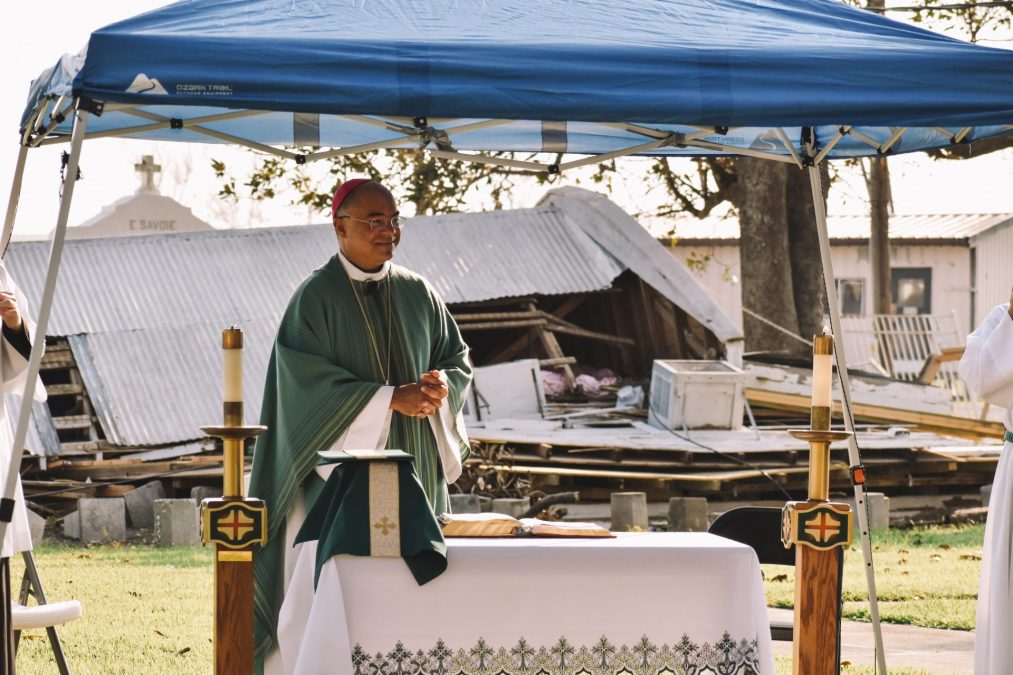
Taxes renew across parishes with low voter turnout election on Saturday
November 14, 2021
Healthy Holidays to You!
November 14, 2021Hurricane Ida plowed her way onshore on August 31, 2021, devastating community after community, tearing apart homes and lives. Once the winds died down and the rain ceased, our people emerged and returned to view what was left behind. As we turned to one another in tears, seeking support and strength, many in our communities turned to the stronghold of our community: our church.
Catholic Charities of Houma-Thibodaux exists to serve the missionary heart of the Church by addressing individual and family needs while providing opportunities for disciples to put their faith into action. Even where the physical church structure was damaged, the heart of the church – the faithful congregation – still gathered to start picking up the scattered pieces of their lives with the help of Catholic Charities.
The Very Rev. Mark Toups has been at the helm for Catholic Charities Hurricane Ida relief mission. Serving as the Pastor of Our Lady of the Isle Catholic Church in Grand Isle, his home parish has been devastated. But he recognizes the role our churches play in our tight-knit communities.
Rev. Toups explained there are three phases in disaster recovery: Respond. Reopen. Recover. Each phase has to happen in the lives of human beings. The Catholic Church aims to help meet each of these phases by walking side-by-side with our people. It’s important to realize that Respond was a number of weeks, Reopen was a number of months and Recovery is going to be a number of years.
Respond
“After the storm, we were faced with meeting basic human needs: food, water, and safe housing. People just naturally look to the church for help with those basic human needs,” shared Rev. Toups. “I can’t emphasize enough, even before Catholic Charities was able to mobilize a regional effort, our church parishes started immediately responding to people’s needs. It was really beautiful to see pastors and their parishioners just kind of jumping in and feeding people and serving people.”
In the Respond phase, Catholic Charities, along with the support of local church parishes, was able to serve approximately 200,000 meals throughout their 39 church parishes.
“The people in this area just do what the people in this area do, which is they come together in a very beautiful way,” shared Rev. Toups. “And when they come together in a very beautiful way, they reach out to those who are in need. And that’s what we saw in the Respond phase. In that first phase, through the efforts in parishes, as well as in some of the support from Catholic Charities, we estimate that we fed close to 200,000 meals in Terrebonne and Lafourche parishes.”
The Church also began to respond to some of the physical damage to their structures.
“Every church is different, from their physical location to their building structures,” explained Rev. Toups. “The entire community of lower Lafourche, lower Terrebonne and Grand Isle was hit hard, not just churches, but neighborhoods and things like that. It took time to take assessments of our buildings and our locations and tarp roofs, and doing whatever we had to just to respond immediately to the needs that were there.”
Reopen
As people’s humanitarian needs were met, Catholic Charities began moving into the next phase, Reopen. They were very intentional in this phase, focusing first on getting school back open. Along with the guidance of Superintendent of Catholic Schools Suzanne Troxclair, our parochial schools started to open as soon as possible.
“We were super intentional about getting all of our Catholic schools back, which meant that some of us had to be real creative,” shared Rev. Toups. “Vandebilt platooned with E.D. White in Thibodaux. We had St. Gregory in Houma, which couldn’t reopen on property. So the pastor in Bourg reached out to the pastor at St. Gregory and said, ‘Hey, I’ve got a facility here.’ They worked out the details amongst themselves! Similarly, the pastor in Raceland reached out to the pastor in Lockport at Holy Savior and said, ‘You can’t reopen at your school. How about you use my place?’ So through some real creative partnerships, we were able to get all our schools open quickly.”
The Church was also very intentional about getting the Pastoral Center up and running quickly to serve as a hub for phase two and three. They also began to reopen each church parish as essential services came back online.
“Some churches are celebrating mass with the lights and the air conditioner on, while some places are operating with the doors open and the power off, and some of our parishes are celebrating mass under a tent,” said Rev. Toups. “But we have had mass in all of our locations throughout this process. We know that people are in need of a lot of things, not only physical things, but emotional support in the recovery phase we are in now.”
Recover
The longest and hardest phase of disaster recovery is where we are now. Recover.
“The focus now is on two primary things. Number one, in parishes who have been most affected, we are doing one-on-one assessments of their needs. Anybody who needs assistance or help, not just Catholics,” shared Rev. Toups. “For example, we have done individual assessments or casework. We’ve done that in Dulac, Dularge, Montegut, Golden Meadow, and and we’re continuing to do that in other locations. The Catholic Church was just there to say, ‘Hey, anybody who has needs, who would like an assessment, come and tell us your story and will tell us what your needs are.’”
Once the individual and community needs have been assessed, the data from these thousands and thousands of assessments is placed into software that can help determine what the long-term humanitarian response will need to be. They can begin walking with people one-on-one through the long process of the applications and the insurance claims
“A lot of what happens with hurricanes and long-term recovery responses, people just get tired because they’ve never been through this and it can be complicated. And if you’re trying to do it alone, sometimes you just kind of give up, especially those who don’t have the resources to respond on their own,” explained Rev. Toups. “We will begin doing case management, where we’re going to be walking with people one-on-one as best as we possibly can. Hopefully, our long-term humanitarian response will be determined once we have that assessment complete. We’re working tirelessly on this stage at the moment.”
Feed My Sheep
Just as Jesus instructed Peter to feed his sheep as a testament of his love, our local priests have heeded the call to feed and serve. This particular call to serve in the aftermath of a disaster takes an emotional toll on everyone involved.
“Our priests have done an amazing job with the resources they have, when it comes to responding to people’s needs. They have been doing heroic work,” declared Rev. Toups. “Bishop Shelton Fabre has also spent significant time with every priest, one-on-one, face-to-face, checking in on them to see how they are doing.”
As Rev. Toups explained, there is a certain emotional rollercoaster to disaster relief that really only makes sense once you’re experienced it.
“And so what happens is once you have the impact, there’s actually an uptake of emotions, right? There’s more hope, the community is coming together, we’re responding to people’s needs. During that uplifting of emotion, which lasts for about a month, maybe six weeks, there’s a lot of hope. And then, there’s a different emotion that sets in. The reality of how long this is going to take, and the reality of the needs that are out there. People begin to get frustrated with the process and how slow things are in long-term recovery. People out of their routine and all kinds of things. And then what usually happens is there is a long and slow emotional downslide. So our pastors are not only dealing with people’s physical needs, but they’re also facing communities that are struggling emotionally in lots of different ways. And so I think the challenges that our pastors face, compared to the first month after impact, are probably different now. The second and third month after impact, as people not only continue to need a lot of things physically, but a lot of people are beginning to struggle emotionally.”
While the volunteers that flooded our community after the storm have all been forced to return to their lives in their states and cities, the Church isn’t going anywhere. As different sets of challenges arise in our communities, the Church has set itself up to continue to be of service for the long haul.
“From the federal, state and local governments to the nonprofits and the faith-based organizations, to just volunteers – if we all come together right now and we make it a little bit easier for people to get through this next phase, then maybe they won’t be so isolated or feel like they are walking alone through this process. We have all been called to work together, to protect what we have in South Louisiana, and to preserve it for the generations to come.”





